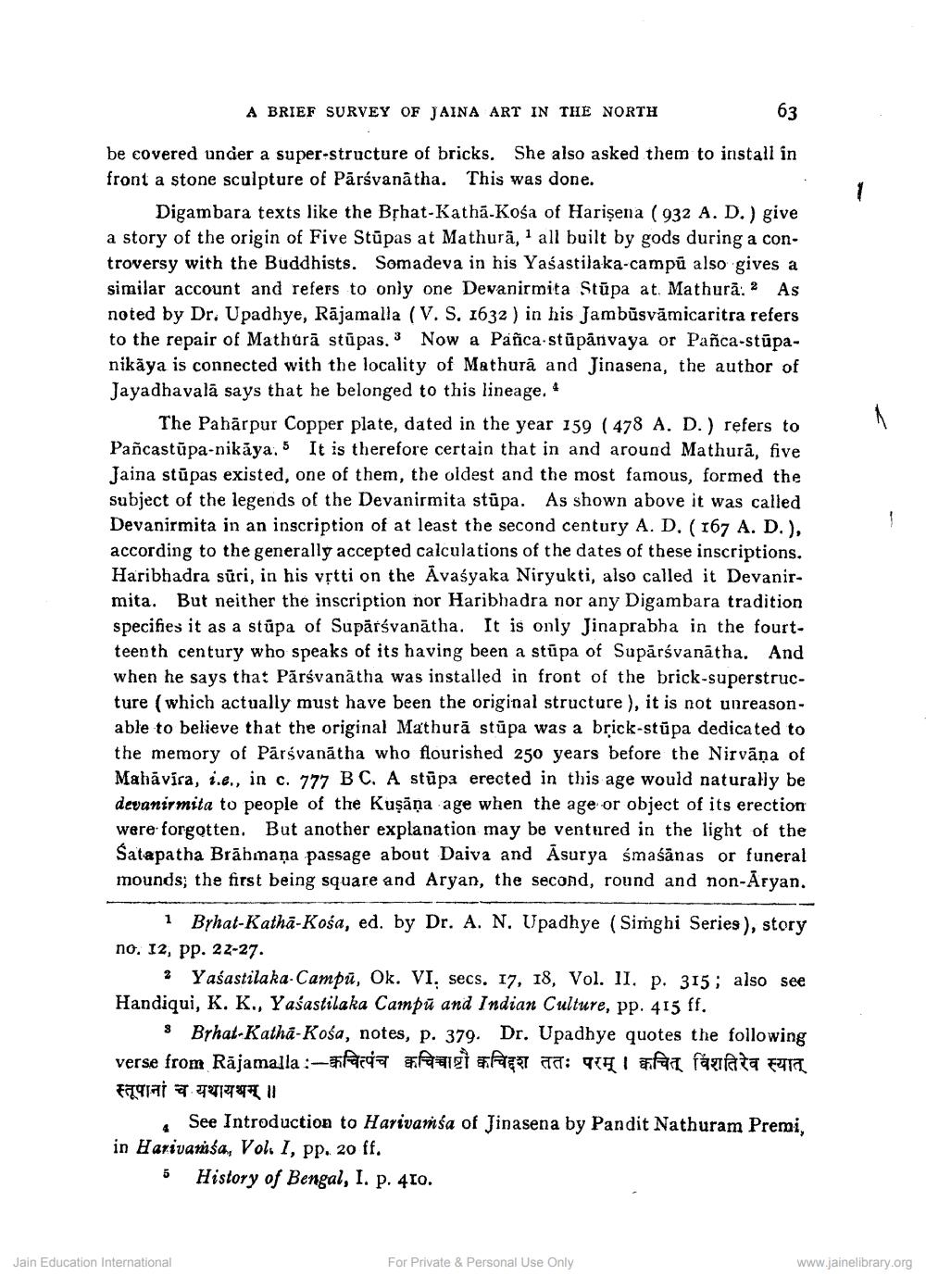________________
63
A BRIEF SURVEY OF JAINA ART IN THE NORTH
be covered under a super-structure of bricks. She also asked them to install in front a stone sculpture of Parsvanatha. This was done.
Digambara texts like the Brhat-Katha-Kośa of Harişena (932 A. D.) give a story of the origin of Five Stūpas at Mathura, all built by gods during a controversy with the Buddhists. Somadeva in his Yaśastilaka-campû also gives a similar account and refers to only one Devanirmita Stupa at. Mathura. 2 As noted by Dr. Upadhye, Rājamalla (V. S. 1632) in his Jambusvămicaritra refers to the repair of Mathurā stūpas. Now a Pañca stūpanvaya or Pañca-stūpanikaya is connected with the locality of Mathura and Jinasena, the author of Jayadhavala says that he belonged to this lineage. *
The Paharpur Copper plate, dated in the year 159 (478 A. D.) refers to Pañcastūpa-nikāya. It is therefore certain that in and around Mathura, five Jaina stūpas existed, one of them, the oldest and the most famous, formed the subject of the legends of the Devanirmita stúpa. As shown above it was called Devanirmita in an inscription of at least the second century A. D. (167 A. D.), according to the generally accepted calculations of the dates of these inscriptions. Haribhadra suri, in his vṛtti on the Avasyaka Niryukti, also called it Devanirmita. But neither the inscription nor Haribhadra nor any Digambara tradition specifies it as a stapa of Supärśvanatha. It is only Jinaprabha in the fourt teenth century who speaks of its having been a stupa of Supärśvanatha. And when he says that Pärśvanatha was installed in front of the brick-superstructure (which actually must have been the original structure ), it is not unreasonable to believe that the original Mathurā stūpa was a brick-stūpa dedicated to the memory of Parsvanatha who flourished 250 years before the Nirvana of Mahavira, i.e., in c. 777 BC. A stupa erected in this age would naturally be devanirmita to people of the Kuşâna age when the age or object of its erection were forgotten. But another explanation may be ventured in the light of the Satapatha Brahmana passage about Daiva and Asurya śmaśānas or funeral mounds; the first being square and Aryan, the second, round and non-Aryan.
1 Brhat-Katha-Kosa, ed. by Dr. A. N. Upadhye (Simghi Series), story no. 12, pp. 22-27.
Yasastilaka Campi, Ok. VI, secs. 17, 18, Vol. 11. p. 315; also see Handiqui, K. K., Yasastilaka Campa and Indian Culture, pp. 415 ff.
Brhat-Katha-Kosa, notes, p. 379. Dr. Upadhye quotes the following verse from Rajamalla : - कचित्पंच क्वचिचाष्टौ क्वचिद्दश ततः परम् । क्वचित् विंशतिरेव स्यात् स्तूपानां च यथायथम् ॥
See Introduction to Harivamia of Jinasena by Pandit Nathuram Premi, in Harivansa, Voh I, pp. 20 ff.
5 History of Bengal, I. p. 410.
Jain Education International
For Private & Personal Use Only
www.jainelibrary.org




